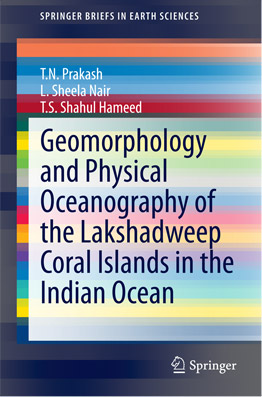Research Updates
 The Lakshadweep islands are a group of 36 coral islands in the Indian Ocean. These small islands are unique for their aquatic bio-diversity and vast blue lagoons. This book presents the results of studies done by the authors during the period 1990 to 2009 that address the beach morphology, hydrodynamics, energy resources and management options with special reference to the issue of both natural and anthropogenic coastal erosion. The relatively low island elevation makes the islands more susceptible to high-wave attack and coastal flooding during adverse weather conditions. The islands are also prone to risks from episodic events like cyclones and deep depressions. This highlights the need for a comprehensive study of the wave, climate and coastal processes at work during different seasons to delineate the factors responsible for shoreline changes and also to identify the locations that need protection and the management options. This book will serve as a guide to researchers, scholars and students who are interested in the coastal processes of coral islands.
The Lakshadweep islands are a group of 36 coral islands in the Indian Ocean. These small islands are unique for their aquatic bio-diversity and vast blue lagoons. This book presents the results of studies done by the authors during the period 1990 to 2009 that address the beach morphology, hydrodynamics, energy resources and management options with special reference to the issue of both natural and anthropogenic coastal erosion. The relatively low island elevation makes the islands more susceptible to high-wave attack and coastal flooding during adverse weather conditions. The islands are also prone to risks from episodic events like cyclones and deep depressions. This highlights the need for a comprehensive study of the wave, climate and coastal processes at work during different seasons to delineate the factors responsible for shoreline changes and also to identify the locations that need protection and the management options. This book will serve as a guide to researchers, scholars and students who are interested in the coastal processes of coral islands.
Rain drop size distribution (DSD) was measured at four places in Southern India
{Thiruvananthapuram, Kochi, Munnar and Sriharikota (SHAR)} using a Joss-Waldvogel (JW) impact type disdrometer. The data for each minute were corrected for dead time errors and rain rate was computed from the corrected data. The data for a whole month were then sorted according to rain rate (R) into several classes ranging from 0.1 to >100 mm/h.
Recent clinical trials conducted by CESS in collaboration with the Regional Cancer Center, Trivandrum has shown that diffuse reflection spectroscopy (DRS) could turn out to be a highly sensitive tool to classify oral cavity tissues especially those of the tongue and lip that have poor classification sensitivities with laser-induced autofluorescence (LIAF). In this technique the DR ratio of oxygenated hemoglobin absorption
In India, Kerala state is known to have relatively high lightning incidence. The nature of spatial and temporal distribution of past incidents, type of thunderclouds which cause lightning, the topography, proximity to a mountain range and sea point to the possibility of the mountain weather aiding in Cumulonimbus cloud (Cb) formation. For investigating the role of mountain weather in convective Cb formation a field station consisting of an automatic weather station and a lightning detector was established
Centre for Earth Science Studies in collaboration with Indian National Centre for Ocean Information Services (INCOIS) under the Ministry of Earth Sciences (MoES), Government of India has recently installed first of two stations scheduled off Coastal waters of Kerala at 30m depth off Trivandrum. The coastal station will give real time data on coastal weather conditions which includes tide, current and wave parameters. This information is vital to the local community,




 RTI Act
RTI Act
